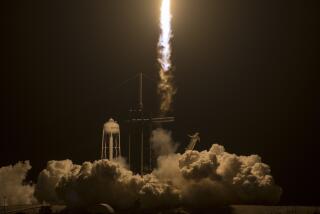Space Station Safe Despite Near-Miss
- Share via
CAPE CANAVERAL, Fla. — Flight controllers botched an attempt to move the new international space station out of the way of a speeding piece of space junk, but the rocket debris ended up passing at a safe distance.
The incident was disclosed by NASA on Thursday.
NASA said the sequence of computer commands sent up by flight controllers to fire the station’s engines failed because of human error.
Initially, the U.S. military organization that tracks objects in space predicted the rocket chunk would pass within two-thirds of a mile of the space station on Sunday. It ended up coming no closer than 4 1/2 miles.
The rocket debris was Russian in origin and fairly large, although its exact dimensions were not immediately known. If it had collided with the space station, it could have destroyed the empty outpost, which has been in orbit for only seven months. The first residents are not due to arrive until next spring.
Measures have been taken to prevent such an incident from happening again, said Frank Culbertson, NASA deputy program manager for space station operations.
At last count, the U.S. Space Command in Colorado Springs, Colo., was tracking more than 8,700 man-made objects in orbit, most of it junk. With an orbital speed of 17,500 mph, any one of them could do serious damage to the space station, which consists of only two compartments so far.
“I’m very glad we learned what we learned at this point in the mission before we have more hardware up there and before we have people up there,” Culbertson said. But he noted that if astronauts had been aboard, they could have maneuvered the space station more easily than ground controllers.
The maneuvering command, drawn up by U.S. and Russian engineers, was sent from the Russian control center outside Moscow on Saturday night. But the command contained faulty instructions, and the space station’s computers rejected it.
Culbertson said it wasn’t immediately clear whether Americans or Russians were to blame.
By the time flight controllers learned of their mistake, it was too late to send up a corrected debris-avoiding command.
In any case, the Space Command soon revised the projected distance between the two objects from 0.6 miles to 4.5 miles.
This is the second time in less than three months that NASA has reported erroneous station commands. In late April, Russian controllers mistakenly ordered a motor to move the space station’s solar wings; fortunately, on-board computers detected the error and shut off the motor.
More to Read
Sign up for Essential California
The most important California stories and recommendations in your inbox every morning.
You may occasionally receive promotional content from the Los Angeles Times.













